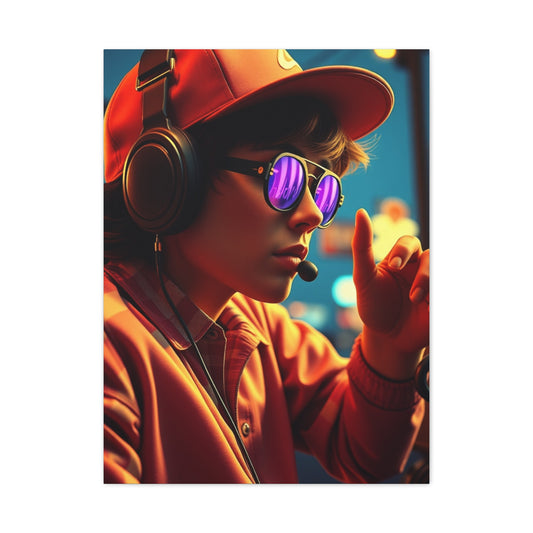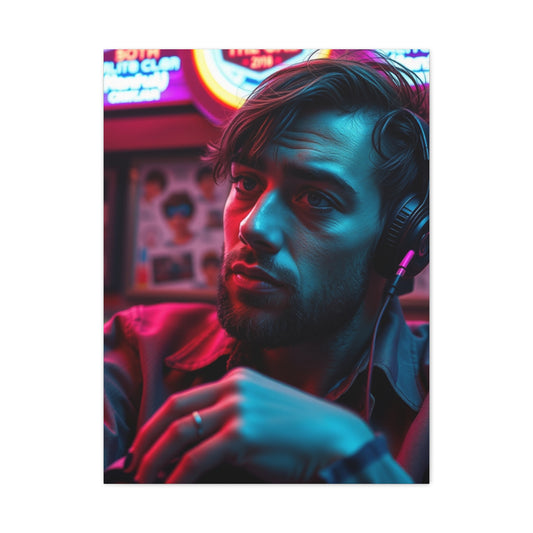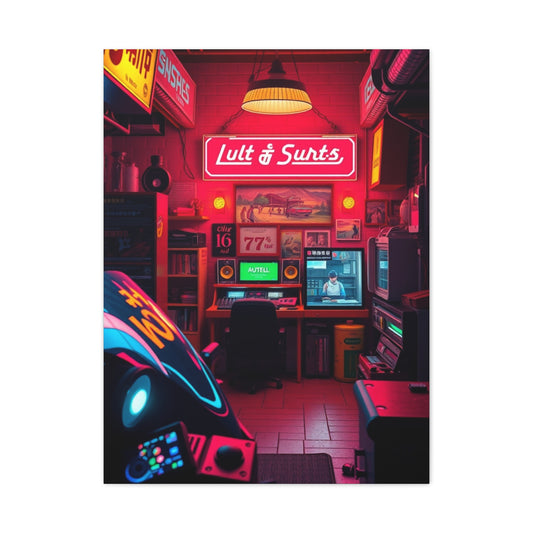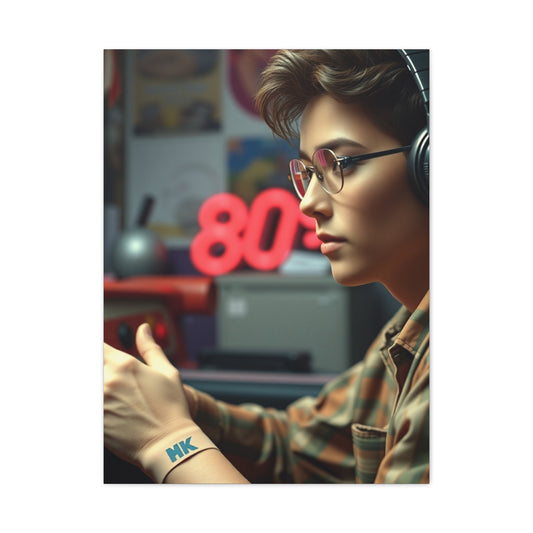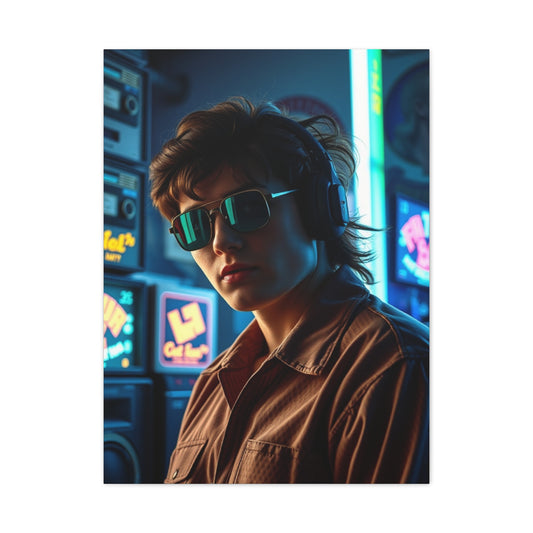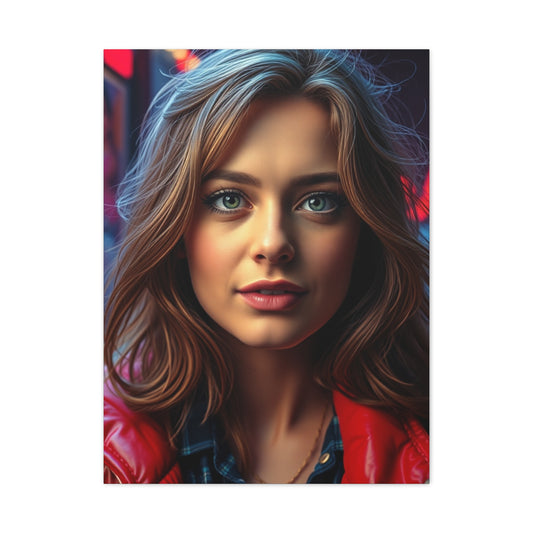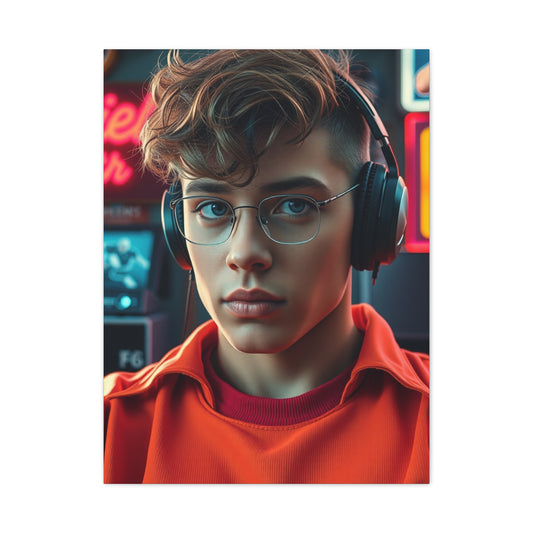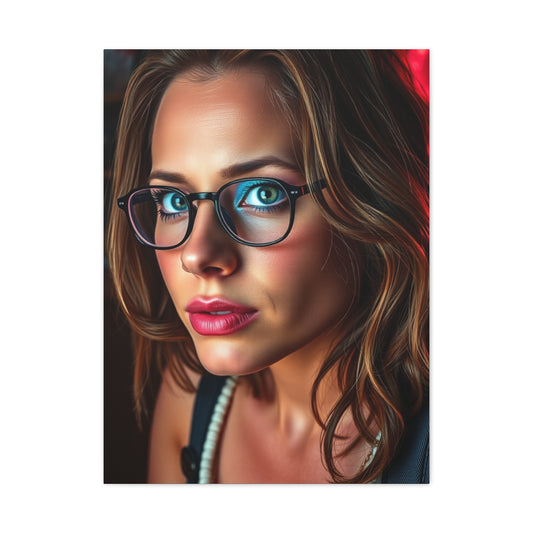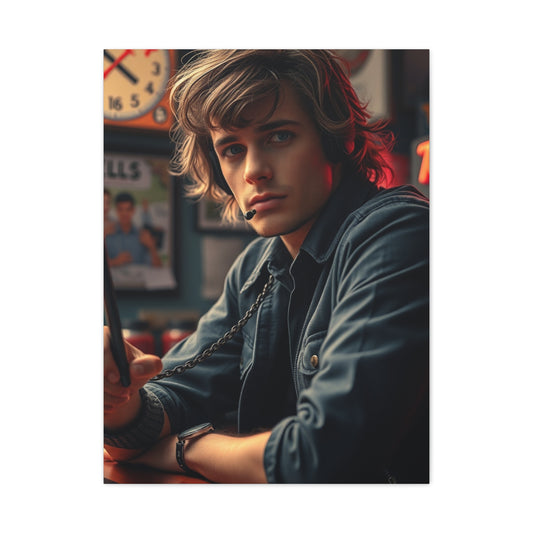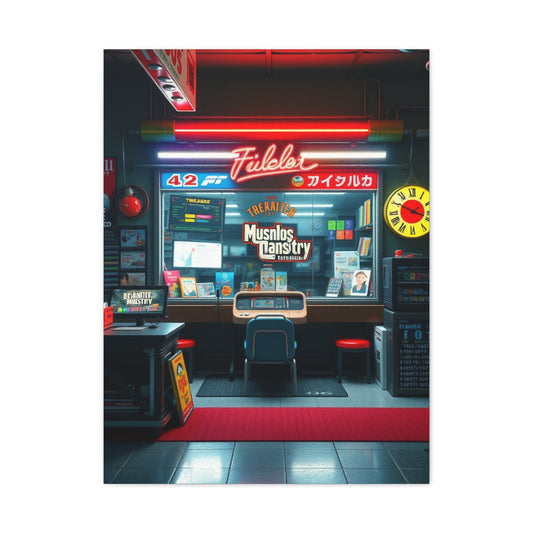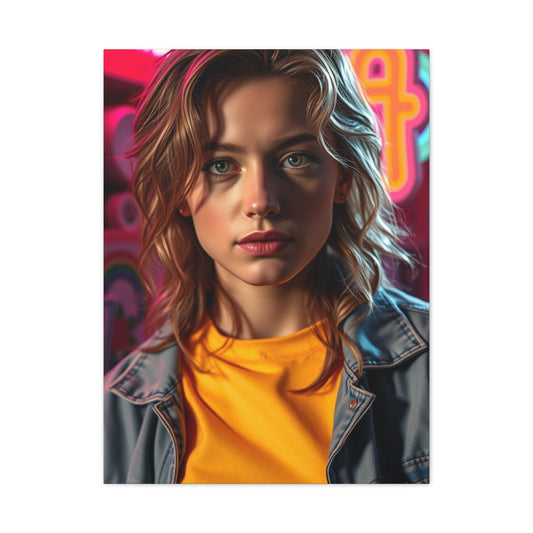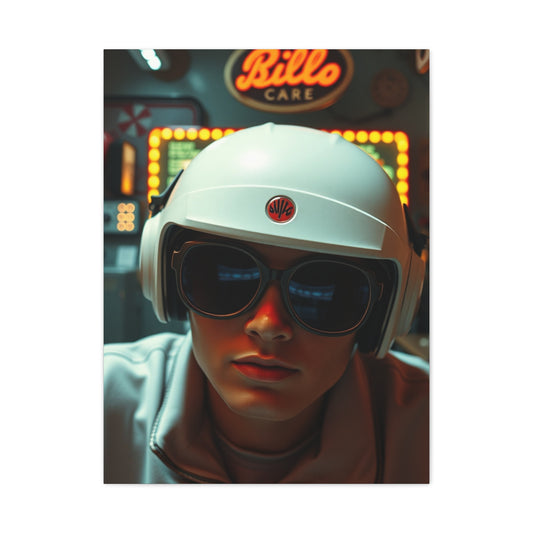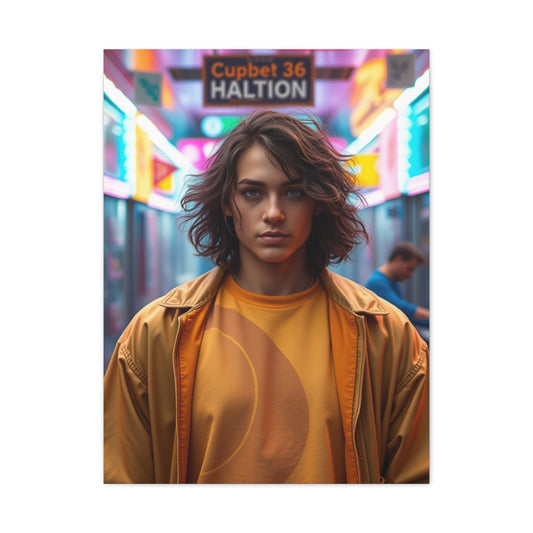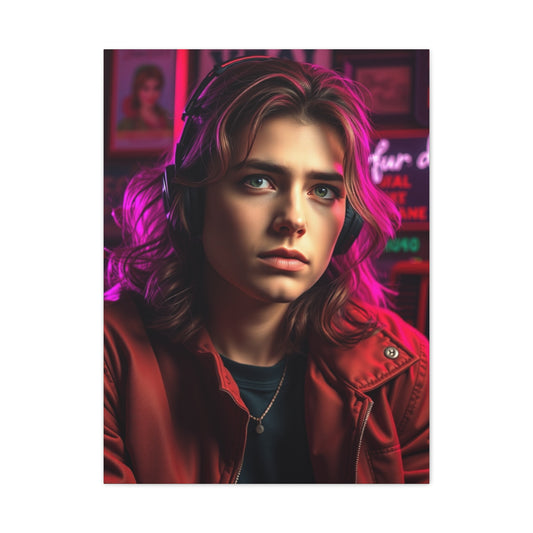Revitalize Your Space: Mastering the 80’s Nostalgia Wall Art Vibe in Room Design
The extraordinary renaissance of 1980s aesthetics within contemporary interior design represents one of the most captivating cultural phenomena of our time, as homeowners increasingly embrace the decade's distinctive visual language that celebrates unbridled creativity, technological optimism, and audacious self-expression. This remarkable revival of the 80's art vibe in room design transcends mere nostalgic recreation to encompass sophisticated understanding of period design principles that prioritized innovation, individualism, and visual impact over conventional decorative restraint.
The transformative power of incorporating authentic 1980s design elements extends far beyond superficial stylistic choices to encompass fundamental philosophical approaches to spatial creation that emphasize energy, dynamism, and forward-thinking vision. This extraordinary decade introduced revolutionary concepts about color psychology, material experimentation, and spatial relationships that continue influencing contemporary design professionals while inspiring homeowners seeking alternatives to minimalist aesthetic solutions that have dominated recent decades.
Understanding the enduring appeal of the 80's art vibe requires examining the complex cultural, technological, and artistic forces that shaped this remarkable period of domestic innovation. The decade's design philosophy emerged from technological advancement, economic prosperity, and cultural confidence that created unprecedented opportunities for creative expression while establishing new standards for residential comfort, entertainment, and lifestyle enhancement that reflected emerging digital culture and global connectivity.
The contemporary revival of 1980s interior design demonstrates remarkable adaptability as modern practitioners successfully integrate period-specific elements with current lifestyle requirements, technological infrastructure, and sustainability concerns. This successful fusion creates living spaces that honor historical precedent while meeting contemporary functional demands and aesthetic preferences that reflect evolved understanding of domestic comfort, technological integration, and environmental responsibility within residential contexts.
The significance of mastering authentic 80's art vibe implementation extends beyond immediate aesthetic gratification to encompass psychological benefits associated with vibrant color exposure, creative stimulation, and personal expression that support mental wellbeing and social engagement. Research demonstrates significant connections between dynamic visual environments and enhanced creativity, improved mood stability, and increased social interaction that validate period design principles while supporting contemporary wellness initiatives and lifestyle enhancement goals.
Foundational Principles of Eighties Aesthetic Philosophy
The extraordinary aesthetic revolution that characterized the 1980s established entirely new paradigms for interior design that challenged traditional decorative hierarchies while embracing technological innovation, cultural diversity, and expressive individualism that reflected broader social transformations occurring throughout this dynamic decade. This revolutionary approach to environmental creation prioritized visual impact, emotional stimulation, and technological integration over conventional notions of decorative propriety and historical continuity.
Maximalist design philosophy emerged as defining characteristic of 1980s interior aesthetics, rejecting minimalist restraint in favor of abundant visual information, layered textures, and complex pattern relationships that created stimulating environments designed to energize occupants while reflecting period optimism and cultural confidence. This sophisticated maximalism required careful orchestration of diverse elements while maintaining overall coherence through strategic color coordination and spatial organization that prevented visual chaos.
The integration of popular culture references within serious interior design represented fundamental shift in decorative philosophy that acknowledged entertainment industry influence while celebrating mass media aesthetics as legitimate artistic expression deserving residential application. This democratic approach to cultural validation challenged elitist distinctions between high and low culture while creating environments that reflected authentic contemporary experience rather than historical emulation.
Technological optimism permeated 1980s design philosophy through enthusiastic adoption of synthetic materials, electronic devices, and futuristic aesthetic references that expressed confidence in technological progress while creating environments that anticipated digital lifestyle integration. This forward-thinking approach established important precedents for contemporary smart home integration while demonstrating successful incorporation of advancing technology within residential contexts.
The celebration of artificial aesthetics during the 1980s represented radical departure from previous decades' emphasis on natural materials and organic forms while establishing new appreciation for synthetic beauty, manufactured precision, and technological enhancement. This artificial aesthetic embraced plastic laminates, metallic finishes, and electronic lighting while creating environments that celebrated human ingenuity and manufacturing capability rather than natural authenticity.
Global cultural fusion achieved unprecedented sophistication during the 1980s as improved international communication enabled widespread exposure to diverse aesthetic traditions that enriched American design vocabularies while creating more culturally inclusive and globally aware interior environments. This international influence included Japanese minimalism, Mediterranean colorfulness, and tropical exuberance that created eclectic combinations reflecting period cultural curiosity and global awareness.
The emphasis on entertainment and leisure within 1980s residential design reflected changing lifestyle patterns that prioritized home-based recreation, social gathering, and technological engagement while creating environments specifically designed to support these activities through specialized spatial organization, technical infrastructure, and atmospheric enhancement that anticipated contemporary home entertainment requirements.
Chromatic Revolution and Color Psychology Implementation
The extraordinary color revolution that defined 1980s interior design represented radical departure from previous decades' restrained palettes while establishing bold new standards for residential chromatic expression that celebrated psychological stimulation, emotional enhancement, and visual dynamism over conventional decorative conservatism. This revolutionary approach to color application drew inspiration from emerging understanding of color psychology, advancing printing technologies, and cultural movements that emphasized personal expression and creative liberation.
Neon color integration achieved unprecedented prominence during this period, bringing electric blues, shocking pinks, vivid greens, and brilliant yellows into residential environments through innovative application techniques that included accent walls, furniture selections, and decorative accessories. These high-intensity colors required sophisticated balancing strategies while creating dramatic focal points that energized spaces and reflected period fascination with technological advancement and artificial enhancement.
Miami Vice palette influence introduced sophisticated pastel combinations that balanced vibrant intensity with elegant restraint while creating environments that suggested luxury, sophistication, and contemporary lifestyle aspiration. This influential color scheme combined soft corals, pale aquas, delicate lavenders, and creamy whites that created serene yet stimulating environments suitable for both relaxation and entertainment activities.
Metallic accent integration became essential component of authentic 1980s color schemes through strategic application of chrome, brass, copper, and silver finishes that provided reflective surfaces, technological references, and luxurious enhancement while connecting interior environments to period automotive design, electronic device aesthetics, and industrial advancement. These metallic elements required careful coordination with other color choices while creating opportunities for dramatic lighting effects and visual emphasis.
The psychological impact of 1980s color choices extended beyond aesthetic considerations to influence mood, energy levels, and social behavior within residential environments designed to support active lifestyles and dynamic social interaction. Research from this period demonstrated significant connections between vibrant color exposure and enhanced creativity, improved mood stability, and increased social engagement that validated bold chromatic approaches while supporting contemporary wellness initiatives.
Gradient and ombre effects achieved remarkable sophistication through innovative application techniques that created smooth color transitions, dimensional depth, and visual movement within static interior elements. These complex color relationships required advanced technical skill while creating dynamic environments that changed appearance under different lighting conditions and viewing angles, providing ongoing visual interest and discovery opportunities.
The successful integration of multiple bold colors within unified design schemes required sophisticated understanding of color theory, proportion relationships, and visual balance that prevented overwhelming sensory experiences while maintaining period authenticity and design coherence. This complex color orchestration demanded careful attention to saturation levels, temperature relationships, and spatial distribution while creating harmonious yet dynamic environments.
Color blocking techniques achieved widespread application during this period, creating dramatic visual statements through large areas of unified color that established strong spatial definition while providing effective background for furniture placement and decorative accessories. These bold color applications required confident implementation while creating opportunities for furniture and artwork to achieve maximum visual impact against dramatic chromatic backgrounds.
Iconic Cultural References and Entertainment Integration
The extraordinary integration of popular culture references within 1980s interior design represented fundamental shift in decorative philosophy that acknowledged entertainment industry influence while celebrating mass media aesthetics as legitimate artistic expression deserving residential application. This democratic approach to cultural validation challenged traditional distinctions between fine art and commercial imagery while creating environments that reflected authentic contemporary experience rather than historical emulation or cultural pretension.
Movie poster applications achieved unprecedented sophistication as homeowners embraced cinematic imagery that captured period cultural zeitgeist while providing powerful visual focal points that established thematic coherence and conversational interest within residential environments. These large-scale graphic elements required strategic placement and careful integration with surrounding décor while providing opportunities for dramatic wall treatments and artistic statement creation.
Television show memorabilia gained legitimate decorative status during this period as quality programming achieved cultural significance while providing source material for sophisticated interior design applications. This entertainment integration reflected changing attitudes toward mass media while creating opportunities for personal expression through cultural reference and nostalgia celebration that connected occupants to broader cultural movements and shared experience.
Music industry aesthetics heavily influenced interior design through adoption of recording studio technologies, concert venue lighting techniques, and album artwork imagery that created environments celebrating period musical innovation and cultural influence. This musical integration included sophisticated sound system installations, dramatic lighting design, and graphic display techniques that transformed residential spaces into entertainment venues suitable for social gathering and cultural celebration.
Sports culture integration achieved remarkable prominence during the 1980s through incorporation of athletic imagery, team colors, and recreational equipment that reflected period emphasis on fitness, competition, and physical achievement while creating environments that celebrated active lifestyles and competitive spirit. These sports-themed elements required thoughtful integration while providing opportunities for personal expression through team loyalty and athletic achievement celebration.
Fashion industry influence permeated interior design through adoption of textile patterns, color combinations, and material treatments that reflected period clothing innovation while creating environments that celebrated personal style and fashion consciousness. This cross-pollination between clothing and interior design created cohesive lifestyle expressions while demonstrating sophisticated understanding of aesthetic coordination across multiple design disciplines.
Corporate branding aesthetics gained residential application as successful companies established distinctive visual identities that influenced broader cultural taste while providing source material for interior design inspiration. This corporate influence reflected period business culture celebration while creating opportunities for sophisticated graphic integration and brand aesthetic adaptation within residential contexts that honored commercial design innovation.
The successful integration of diverse cultural references required sophisticated curatorial sensibility that balanced authenticity with personal expression while avoiding commercial cliché or cultural appropriation. This complex cultural navigation demanded understanding of source material significance while creating respectful and meaningful decorative applications that enhanced rather than trivialized original cultural contexts.
Advanced Material Innovation and Textural Complexity
The extraordinary material revolution that characterized 1980s interior design established entirely new paradigms for residential surface treatment and textural integration that embraced synthetic innovation, manufacturing advancement, and technological enhancement while challenging traditional preferences for natural materials and organic textures. This revolutionary approach to material selection prioritized performance characteristics, visual impact, and maintenance efficiency over historical precedent and natural authenticity.
Laminate surface applications achieved unprecedented sophistication through advanced manufacturing processes that enabled realistic wood grain reproduction, exotic material simulation, and abstract pattern creation while providing superior durability and maintenance characteristics compared to natural alternatives. These synthetic surfaces required specialized installation techniques while offering design flexibility and cost efficiency that supported period democratization of luxury aesthetics and high-performance materials.
Vinyl flooring innovations introduced remarkable pattern complexity, color variety, and installation convenience that revolutionized residential floor treatment while providing alternatives to expensive natural materials and labor-intensive installation processes. This synthetic flooring achieved remarkable aesthetic sophistication while offering practical advantages including water resistance, maintenance efficiency, and cost effectiveness that supported period lifestyle preferences and budget considerations.
Metallic finish integration became essential component of authentic 1980s material palette through strategic application of chrome plating, anodized aluminum, brushed brass, and other reflective treatments that provided technological references, luxurious enhancement, and light-amplification effects. These metallic applications required specialized maintenance while creating opportunities for dramatic visual statements and sophisticated material coordination that enhanced period aesthetic authenticity.
Fabric technology advancement introduced revolutionary synthetic textiles that offered superior performance characteristics including stain resistance, fade protection, and maintenance convenience while achieving remarkable aesthetic sophistication through innovative weaving techniques, pattern printing, and color application methods. These high-performance fabrics enabled bold pattern applications and vibrant color schemes while providing practical advantages for active lifestyle support.
Glass and acrylic integration achieved remarkable prominence through innovative applications that included furniture construction, decorative accessories, and architectural elements that provided transparency, light transmission, and spatial enhancement while reflecting period fascination with technological advancement and material innovation. These transparent materials required specialized handling while creating opportunities for sophisticated lighting effects and visual transparency that enhanced spatial perception.
The layering of diverse materials within unified design schemes created complex textural landscapes that provided sensory richness and visual interest while demonstrating sophisticated understanding of material coordination and proportional relationships. This complex material orchestration required careful attention to compatibility, maintenance requirements, and visual balance while creating environments that rewarded tactile exploration and detailed observation.
Quality considerations within 1980s material selection emphasized performance characteristics, aesthetic impact, and technological advancement while establishing new standards for residential material applications that balanced innovation with reliability. This sophisticated material evaluation supported informed purchasing decisions while ensuring long-term satisfaction with material selections that maintained appearance and functionality under normal residential use conditions.
Sophisticated Lighting Design and Atmospheric Engineering
The extraordinary lighting innovations that emerged during the 1980s fundamentally transformed approaches to residential illumination while establishing new standards for atmospheric creation that prioritized mood enhancement, technological integration, and dramatic visual effects over purely functional considerations. This revolutionary period witnessed remarkable creativity in lighting design that reflected broader cultural interests in technological advancement, entertainment enhancement, and environmental manipulation through sophisticated illumination control.
Track lighting systems achieved widespread residential adoption during this period, providing flexible illumination solutions that could adapt to changing furniture arrangements while supporting period preferences for adjustable, high-tech lighting installations. These innovative systems enabled homeowners to create customized lighting schemes while maintaining design flexibility and accommodation for evolving spatial requirements and activity patterns that reflected dynamic lifestyle preferences.
Recessed lighting integration became essential component of sophisticated 1980s interior design through precise installation techniques that provided clean, architectural illumination while avoiding visual clutter and maintaining period preferences for streamlined, technological aesthetics. These concealed lighting systems required careful planning and professional installation while creating opportunities for dramatic atmospheric effects and sophisticated illumination control.
Colored lighting effects achieved remarkable sophistication through various technological innovations including colored bulbs, gel filters, and computerized control systems that created dynamic atmospheric effects supporting period entertainment and social activities. These innovative lighting applications reflected growing interest in environmental manipulation and sensory enhancement while providing alternatives to conventional white light illumination that supported themed environments and mood creation.
Neon lighting applications brought commercial signage aesthetics into residential environments through strategic accent installations that provided period-appropriate color enhancement and technological reference while creating dramatic focal points and artistic statements. These specialty lighting elements required professional installation and specialized maintenance while providing unique atmospheric effects unavailable through conventional lighting technologies.
Halogen technology introduction provided superior light quality, color rendering, and energy efficiency compared to traditional incandescent systems while enabling compact fixture designs and precise illumination control that supported period aesthetic preferences for clean, technological lighting solutions. This advanced lighting technology required specialized fixtures while providing enhanced performance characteristics that justified premium pricing and professional installation requirements.
Dimmer control systems achieved remarkable sophistication during this period, enabling precise atmospheric control through electronic switching and remote operation that supported period emphasis on environmental customization and technological convenience. These advanced control systems required electrical system upgrades while providing enhanced flexibility for mood creation and energy conservation that supported contemporary lifestyle preferences.
The integration of natural light remained important consideration within 1980s interior design despite period emphasis on artificial lighting innovation, leading to sophisticated approaches to window treatments, skylights, and reflective surfaces that maximized daylight utilization while controlling glare and heat gain. These daylighting strategies supported energy efficiency while creating healthier interior environments that maintained connection to outdoor conditions and seasonal changes.
Furniture Selection and Spatial Organization Principles
The extraordinary furniture innovations that characterized the 1980s established entirely new paradigms for residential furnishing that prioritized technological integration, visual impact, and lifestyle support over traditional formality and historical precedent. This revolutionary approach to furniture design reflected broader cultural shifts toward casualness, entertainment focus, and technological adoption while establishing new standards for comfort, functionality, and aesthetic expression within contemporary domestic environments.
Modular seating systems achieved remarkable sophistication during this period, enabling homeowners to create customized arrangements that could adapt to entertaining needs while maintaining design coherence and visual unity. These revolutionary furniture concepts reflected growing interest in flexibility, social interaction, and entertainment hosting while providing efficient space utilization and reconfiguration capabilities that supported evolving lifestyle patterns and social expectations.
Glass and metal furniture combinations created distinctive 1980s aesthetic signatures through innovative material combinations that emphasized transparency, reflection, and technological advancement while providing functional surfaces and storage solutions. These contemporary furniture pieces required specialized maintenance while creating opportunities for sophisticated lighting effects and spatial enhancement that supported period preferences for clean, uncluttered environments.
Entertainment center integration became crucial component of 1980s residential design as advancing home electronics required specialized housing and display solutions while maintaining aesthetic integration with surrounding furnishings. These technological accommodations reflected changing lifestyle patterns while requiring careful planning for cable management, ventilation, and equipment accessibility that anticipated contemporary home theater requirements.
Built-in storage solutions achieved unprecedented sophistication through innovative design approaches that maximized spatial efficiency while maintaining clean, architectural appearances that supported period preferences for organized, uncluttered environments. These integrated storage systems required professional installation while providing customized solutions for specific storage requirements and spatial constraints that enhanced residential functionality.
Ergonomic considerations gained increasing importance during this period as understanding of human factors influenced furniture design while supporting period emphasis on comfort, health, and lifestyle enhancement. This scientific approach to furniture selection emphasized proper support, appropriate sizing, and user-friendly operation while maintaining aesthetic requirements and style coordination that supported both physical wellbeing and environmental harmony.
The successful integration of diverse furniture styles required sophisticated understanding of scale relationships, proportion coordination, and visual balance that prevented overwhelming sensory experiences while maintaining period authenticity and design coherence. This complex furniture orchestration demanded careful attention to size relationships, color coordination, and spatial distribution while creating harmonious yet dynamic environments that supported diverse activities and social functions.
Quality considerations within 1980s furniture selection emphasized construction durability, aesthetic impact, and technological accommodation while establishing new standards for residential furniture applications that balanced innovation with reliability. This sophisticated furniture evaluation supported informed purchasing decisions while ensuring long-term satisfaction with furniture selections that maintained appearance and functionality under normal residential use conditions and lifestyle demands.
Artistic Integration and Visual Communication Strategies
The extraordinary integration of artistic elements within 1980s interior design represented fundamental shift in decorative philosophy that acknowledged visual communication importance while celebrating diverse artistic expressions as essential components of sophisticated residential environments. This democratic approach to art appreciation challenged traditional hierarchies while creating opportunities for personal expression, cultural reference, and aesthetic enhancement that reflected authentic contemporary taste and individual creativity.
Wall art selection achieved unprecedented diversity during this period as homeowners embraced poster art, photography, graphic design, and contemporary painting that reflected individual interests and cultural connections while challenging traditional fine art assumptions. These varied artistic applications created personalized environments while supporting period values about democratic access to visual culture and creative expression that transcended economic barriers and educational requirements.
Gallery wall arrangements gained sophisticated development through innovative composition techniques that enabled successful integration of diverse artistic elements while creating unified visual statements that enhanced rather than cluttered residential environments. These complex wall treatments required careful attention to scale relationships, color coordination, and visual flow while creating opportunities for ongoing collection development and personal expression evolution.
Sculptural element integration brought three-dimensional artistic expression into residential environments through strategic placement of contemporary sculpture, decorative objects, and artistic accessories that provided textural interest and conversation focus while supporting period preferences for sophisticated cultural reference and artistic appreciation. These sculptural applications required thoughtful positioning while creating opportunities for lighting enhancement and spatial definition.
Photographic display achieved remarkable sophistication as advancing printing technologies enabled high-quality reproduction and large-scale presentation while supporting period interest in documentary photography, fashion imagery, and artistic expression through photographic media. These photographic applications provided opportunities for personal narrative creation while reflecting contemporary visual culture and technological advancement.
The successful curation of diverse artistic elements required sophisticated understanding of visual relationships, thematic coherence, and aesthetic balance while avoiding overwhelming sensory experiences or conflicting artistic statements. This complex artistic orchestration demanded careful attention to scale relationships, color harmonies, and cultural sensitivity while creating meaningful environments that supported personal expression and cultural appreciation.
Installation techniques for various artistic media achieved professional sophistication through proper mounting, appropriate lighting, and protective measures that preserved artwork while ensuring optimal presentation within residential environments. These technical considerations supported long-term artwork preservation while maximizing visual impact and accessibility for ongoing enjoyment and appreciation.
Technological Integration and Smart Environment Creation
The extraordinary technological integration that characterized 1980s interior design established important precedents for contemporary smart home development while demonstrating successful incorporation of advancing electronics within residential environments that maintained aesthetic coherence and functional efficiency. This forward-thinking approach to technology accommodation reflected period optimism about technological progress while creating frameworks for ongoing technological adaptation and lifestyle enhancement.
Home entertainment system design achieved remarkable sophistication through coordinated integration of television, audio equipment, and recording devices while maintaining aesthetic integration with surrounding furnishings and architectural elements. These complex technological installations required careful planning for equipment housing, cable management, and user accessibility while creating centralized entertainment capabilities that anticipated contemporary home theater requirements.
Computer workstation integration began emerging during this period as personal computers gained residential adoption while requiring specialized furniture, electrical infrastructure, and environmental considerations that supported productive computer use within domestic environments. These early computer accommodations established important precedents for contemporary home office design while demonstrating successful integration of advancing technology within residential contexts.
Communication technology housing included telephone systems, intercom networks, and early cellular equipment that required thoughtful integration within interior design schemes while maintaining aesthetic appeal and functional accessibility. These communication accommodations reflected changing lifestyle patterns while requiring specialized installation and maintenance considerations that supported reliable operation and user convenience.
Security system integration achieved increasing sophistication through electronic monitoring, access control, and emergency response capabilities that required coordination with interior design while maintaining residential comfort and aesthetic appeal. These security installations reflected growing safety concerns while requiring careful balance between protection requirements and environmental comfort that supported peaceful residential living.
Climate control advancement included sophisticated HVAC systems, electronic thermostats, and zone control capabilities that provided enhanced environmental comfort while requiring integration within interior design schemes and architectural planning. These environmental systems supported improved energy efficiency while maintaining optimal comfort conditions that enhanced residential satisfaction and lifestyle support.
The successful integration of diverse technological systems required comprehensive planning that considered electrical requirements, ventilation needs, maintenance access, and user interface design while maintaining aesthetic appeal and functional efficiency. This complex technological coordination anticipated contemporary smart home challenges while establishing frameworks for successful technology accommodation within residential environments.
Future-proofing considerations influenced 1980s technological integration through flexible infrastructure, modular system design, and upgrade accommodation that supported ongoing technological advancement while protecting existing investments and maintaining residential functionality. This forward-thinking approach established important precedents for contemporary technology planning while demonstrating successful balance between current requirements and future adaptation capabilities.
Advanced Pattern Integration and Geometric Expression
The extraordinary pattern revolution that defined 1980s interior design represented radical departure from traditional decorative approaches while establishing bold new standards for geometric expression, visual complexity, and artistic integration that celebrated mathematical precision, cultural diversity, and creative innovation over conventional pattern restraint and historical limitation. This sophisticated approach to pattern application required advanced understanding of scale relationships, color coordination, and visual balance while creating dynamic environments that rewarded detailed observation.
Memphis Group influence introduced revolutionary geometric patterns that combined mathematical precision with playful expression while challenging traditional furniture and decorative conventions through bold color combinations and unexpected formal relationships. These innovative patterns required confident application while creating opportunities for artistic statement and cultural reference that reflected period interest in design innovation and creative experimentation.
Op art integration brought sophisticated optical illusions and perceptual challenges into residential environments through strategic pattern applications that created visual movement, dimensional depth, and psychological engagement while demonstrating advanced understanding of visual perception and artistic technique. These complex patterns required careful application while creating dynamic environments that changed appearance under different viewing conditions and lighting situations.
Textile pattern coordination achieved remarkable complexity through successful integration of diverse geometric motifs, cultural references, and artistic expressions within unified decorative schemes that maintained visual coherence while providing sensory richness and ongoing discovery opportunities. This sophisticated pattern orchestration required advanced design skills while creating environments that supported both relaxation and stimulation through carefully balanced visual complexity.
Wallpaper design reached new heights of sophistication through innovative printing technologies that enabled complex pattern reproduction, multiple color applications, and textural effects that created immersive environments and dramatic wall treatments. These advanced wallpaper applications required professional installation while providing opportunities for remarkable spatial transformation and artistic statement creation that supported period aesthetic preferences.
The successful layering of multiple patterns within unified design schemes required sophisticated understanding of scale relationships, color harmonies, and visual rhythm that prevented overwhelming sensory experiences while maintaining design coherence and aesthetic appeal. This complex pattern coordination demanded careful attention to proportion, repetition, and visual flow while creating rich, stimulating environments that supported ongoing visual interest.
Cultural pattern integration brought diverse global traditions into American residential design through respectful adaptation of international motifs, traditional techniques, and cultural symbols that enriched decorative vocabularies while supporting period interest in global awareness and cultural appreciation. These international influences required sensitive application while creating opportunities for cultural education and aesthetic diversity within residential environments.
Professional Implementation and Design Consultation Services
The successful implementation of authentic 1980s design principles within contemporary residential environments often requires professional expertise that combines historical knowledge with current technical requirements while navigating complex challenges related to building codes, energy efficiency, and lifestyle accommodation. Professional design services provide valuable guidance for homeowners seeking period authenticity without compromising contemporary comfort, functionality, or safety standards that support modern residential living.
Historical research capabilities enable design professionals to identify authentic period elements while distinguishing genuine vintage materials from contemporary reproductions that may lack appropriate character, quality standards, or historical accuracy. This expertise prevents costly mistakes while ensuring successful aesthetic integration that honors period design principles through appropriate material selection, application techniques, and stylistic coordination that supports long-term satisfaction and authentic expression.
Technical knowledge about period construction methods enables professional implementation of specialized installations including lighting systems, entertainment centers, and built-in storage solutions while meeting contemporary safety and performance standards. This expertise ensures successful integration of period-appropriate features while maintaining building code compliance, structural integrity, and system reliability that protects occupant safety and investment value.
Vendor relationships developed by design professionals provide access to specialized suppliers, craftspeople, and restoration services that support successful period recreation through authentic materials, expert workmanship, and professional installation techniques. These professional networks enable efficient sourcing of genuine vintage elements while providing alternatives when authentic materials are unavailable, inappropriate, or cost-prohibitive for specific applications.
Project management capabilities ensure successful coordination of multiple trades, suppliers, and installation phases while maintaining schedule adherence and budget control that supports complex renovation projects incorporating authentic period elements. Professional oversight prevents common problems while ensuring quality standards, proper sequencing, and timely completion that supports successful project outcomes within acceptable timeframes and cost parameters.
Custom design services enable personalized adaptations of period principles that accommodate specific site conditions, family requirements, and aesthetic preferences while maintaining historical accuracy and authentic character. This customization ensures successful integration of period elements within unique circumstances while providing solutions that reflect individual needs, lifestyle patterns, and personal preferences rather than generic historical recreation or commercial interpretation.
Ongoing maintenance guidance helps homeowners preserve period design elements while adapting care requirements to contemporary environmental conditions, material availability, and maintenance service options. Professional advice supports long-term preservation while providing practical strategies for addressing wear, damage, or obsolescence that may affect vintage elements, specialized finishes, or unique installations over time.
Contemporary Technology Integration and Digital Enhancement
The successful integration of contemporary technology within 1980s-inspired interior environments requires sophisticated approaches that maintain period aesthetic authenticity while accommodating modern convenience requirements, safety standards, and lifestyle expectations that support twenty-first-century residential living. This complex challenge demands innovative solutions that honor historical design principles while embracing technological advancement and functional enhancement that improves residential comfort and convenience.
Smart home integration requires careful concealment of contemporary technology within period-appropriate housing while maintaining full functionality and user accessibility that supports modern lifestyle patterns. These technical accommodations include hidden wiring systems, concealed control panels, and disguised equipment housing that preserve visual authenticity while providing advanced technological capabilities that enhance residential convenience and efficiency.
Entertainment system evolution from 1980s precedents enables recreation of period entertainment center aesthetics while incorporating contemporary audio-visual equipment, streaming capabilities, and digital media access that support current entertainment preferences. These updated entertainment solutions require specialized housing and installation techniques while maintaining period visual characteristics and spatial relationships that honor authentic design principles.
Lighting control advancement enables sophisticated recreation of period lighting effects while incorporating LED technology, automated controls, and energy efficiency improvements that support contemporary environmental standards and operational convenience. These advanced lighting systems provide authentic atmospheric effects while achieving superior performance characteristics and reduced environmental impact that supports sustainable residential operation.
Communication technology integration includes contemporary telephone systems, internet infrastructure, and mobile device charging capabilities while maintaining period aesthetic integrity and spatial organization principles. These communication accommodations require careful planning for equipment placement, cable management, and user accessibility while preserving authentic environmental character and visual coherence.
Security system modernization enables contemporary protection capabilities while maintaining period aesthetic integrity through concealed sensors, hidden cameras, and integrated control systems that provide advanced security features without compromising authentic design elements or environmental comfort. These security accommodations support contemporary safety requirements while preserving residential ambiance and aesthetic authenticity.
Climate control enhancement includes contemporary HVAC systems, programmable thermostats, and energy management capabilities that provide improved environmental comfort while maintaining period aesthetic principles and spatial relationships. These environmental systems achieve superior performance while supporting authentic design integration and energy efficiency that meets contemporary environmental standards and operational requirements.
Sustainable Implementation and Environmental Responsibility
The contemporary implementation of 1980s design principles within environmentally conscious residential projects requires sophisticated approaches that honor period aesthetic authenticity while addressing urgent sustainability concerns through responsible material selection, energy efficiency optimization, and environmental impact reduction that supports long-term ecological stewardship and residential sustainability.
Material selection strategies prioritize sustainable alternatives that achieve authentic period aesthetics while reducing environmental impact through renewable resources, recycled content, and responsible manufacturing processes that minimize ecological footprint. These sustainable materials include bamboo laminates, recycled glass surfaces, and reclaimed metal elements that provide authentic visual characteristics while supporting environmental responsibility and resource conservation.
Energy efficiency optimization enables authentic recreation of period lighting effects and environmental control while achieving contemporary performance standards through LED technology, programmable systems, and advanced insulation techniques that reduce energy consumption and operational costs. These efficiency improvements provide authentic atmospheric effects while supporting environmental responsibility and economic sustainability.
Waste reduction strategies include furniture restoration, material repurposing, and selective demolition techniques that minimize construction waste while preserving valuable materials and reducing disposal requirements. These conservation approaches support authentic material preservation while reducing environmental impact and project costs that benefit both ecological stewardship and budget management.
Indoor air quality considerations influence material selection and installation techniques while supporting healthy interior environments through low-emission products, adequate ventilation, and natural material preferences that reduce toxic exposure and enhance occupant wellbeing. These health-conscious approaches support authentic material preferences while ensuring safe residential environments that protect occupant health and comfort.
Longevity planning emphasizes durable material selection and quality construction techniques that provide extended service life while reducing replacement frequency and associated environmental impact. This long-term approach supports authentic period principles about quality investment while reducing ongoing environmental costs and maintenance requirements that benefit both ecological responsibility and economic sustainability.
Water conservation strategies include efficient plumbing fixtures, sustainable landscaping, and water management systems that reduce consumption while maintaining residential comfort and functionality. These conservation measures support contemporary environmental standards while preserving authentic design principles and spatial relationships that maintain period aesthetic integrity.
Cultural Sensitivity and Authentic Expression
The respectful implementation of 1980s cultural references within contemporary interior design requires sophisticated understanding of historical context, cultural significance, and appropriate adaptation that honors source materials while avoiding stereotypes, appropriation, or trivialization that could diminish cultural value or cause offense to originating communities. This sensitive approach ensures authentic expression while maintaining respect for diverse cultural contributions and artistic traditions.
Historical accuracy research enables proper understanding of period cultural movements, artistic developments, and social contexts that influenced original design elements while providing foundation for respectful contemporary adaptation and authentic recreation. This scholarly approach prevents misrepresentation while ensuring accurate cultural reference and appropriate historical interpretation that honors original intentions and cultural significance.
Cultural consultation provides valuable guidance for appropriate adaptation of international design influences, traditional motifs, and cultural symbols while ensuring respectful application and avoiding inappropriate appropriation or cultural insensitivity. These consultation services support authentic cultural integration while maintaining respect for originating traditions and contemporary cultural considerations that preserve cultural dignity and historical accuracy.
Artistic attribution recognizes original creators, cultural sources, and historical influences while providing proper credit and cultural acknowledgment that supports artistic integrity and cultural respect. This attribution practice ensures ethical design implementation while supporting contemporary understanding of cultural contributions and artistic heritage that enriches overall design appreciation and cultural education.
Contemporary relevance ensures that cultural references remain meaningful and appropriate within current social contexts while maintaining historical accuracy and cultural sensitivity that supports ongoing cultural appreciation and educational value. This relevance consideration prevents dated or inappropriate cultural references while ensuring continued cultural significance and educational benefit within contemporary residential environments.
Community engagement includes consultation with cultural organizations, artistic communities, and historical societies that provide valuable guidance for appropriate cultural integration and authentic historical interpretation. These community connections support accurate design implementation while building positive relationships with cultural stakeholders and educational institutions that enhance project value and cultural understanding.
Educational opportunity creation includes design documentation, cultural explanation, and historical context provision that enhances occupant understanding and visitor appreciation while supporting ongoing cultural education and historical awareness. These educational components add value beyond immediate aesthetic benefit while supporting cultural preservation and historical understanding that enriches residential experience.
Future Evolution and Continuing Influence
The enduring influence of 1980s design principles provides valuable foundation for addressing contemporary design challenges while suggesting future directions that build upon period innovations through enhanced understanding of environmental impact, technological integration, and cultural sensitivity that supports continued relevance and ongoing adaptation within evolving residential contexts.
Technological advancement continues expanding possibilities for authentic recreation of period effects while achieving superior performance characteristics through LED lighting, digital controls, and smart home integration that maintains aesthetic authenticity while providing enhanced functionality and environmental responsibility. These technological developments enable more accurate period recreation while supporting contemporary convenience and efficiency requirements.
Environmental awareness influences material selection and implementation techniques while supporting sustainable approaches to period recreation that minimize ecological impact while maintaining authentic aesthetic characteristics. This environmental consciousness builds upon period innovation while addressing contemporary sustainability concerns through responsible material choices and energy efficiency optimization.
Cultural evolution continues enriching design vocabularies through ongoing global exchange, artistic development, and cultural appreciation that expands available aesthetic influences while maintaining respect for cultural significance and historical accuracy. This cultural evolution supports continued design innovation while preserving cultural integrity and authentic expression that honors diverse contributions and artistic traditions.
Educational development enhances understanding of period design principles while supporting proper implementation and cultural sensitivity that ensures respectful and accurate design application. This educational emphasis supports continued appreciation while preventing misrepresentation and cultural appropriation that could diminish historical value or cultural significance.
Professional specialization continues developing expertise in period design recreation while supporting high-quality implementation and authentic expression that meets contemporary standards for quality, safety, and environmental responsibility. This professional development ensures continued availability of qualified practitioners while maintaining high standards for historical accuracy and cultural sensitivity.
The ongoing relevance of 1980s design principles demonstrates remarkable adaptability while providing continuing inspiration for contemporary practitioners seeking alternatives to current design trends and commercial solutions. This enduring influence supports continued innovation while honoring historical precedent and cultural contribution that enriches contemporary design practice and residential experience.
Conclusion
The extraordinary revival of the 80's art vibe in room design represents far more than nostalgic recreation, encompassing sophisticated understanding of period design principles that celebrated creativity, technological advancement, and cultural diversity while establishing enduring standards for residential comfort, entertainment, and personal expression that continue influencing contemporary interior design practice. This remarkable aesthetic movement demonstrates lasting relevance through successful adaptation to contemporary needs while maintaining authentic character and cultural significance.
The successful implementation of authentic 1980s design elements within contemporary residential environments requires comprehensive understanding of both historical context and current requirements while maintaining aesthetic integrity that honors period innovation without compromising contemporary functionality, safety, or environmental responsibility. This challenging balance demands professional expertise, careful planning, and thoughtful adaptation that respects historical precedent while meeting modern lifestyle expectations.
The cultural impact of 1980s design philosophy extends beyond immediate aesthetic influence to encompass fundamental approaches to creativity, technology integration, and personal expression that continue providing valuable guidance for contemporary challenges including sustainability, cultural sensitivity, and technological advancement. These enduring principles demonstrate remarkable prescience while supporting continued innovation and cultural contribution within evolving design contexts.
The environmental consciousness increasingly influencing contemporary design practice finds natural alignment with 1980s innovation principles while supporting sustainable approaches to period recreation that minimize ecological impact without compromising aesthetic authenticity or cultural significance. This environmental integration ensures continued relevance while addressing urgent sustainability concerns through responsible implementation and material selection.
Future developments in 1980s-inspired design will likely incorporate enhanced technological capabilities, improved environmental performance, and expanded cultural awareness while maintaining essential characteristics that made period design successful including creativity, innovation, and personal expression. This ongoing evolution ensures continued relevance while supporting adaptation to emerging challenges and opportunities within contemporary residential design practice.
The lasting appeal of the 80's art vibe reflects fundamental human needs for creativity, stimulation, and personal expression that transcend temporary fashion trends while providing frameworks for authentic environmental creation that supports individual wellbeing and cultural appreciation. This enduring significance ensures continued influence while inspiring future innovations that build upon period achievements through contemporary understanding and technological advancement.

